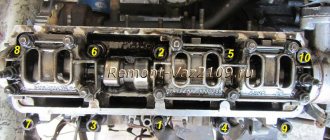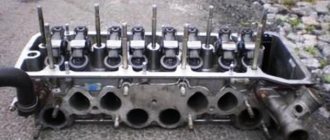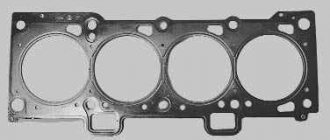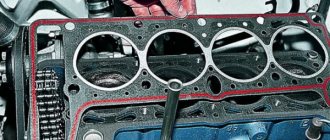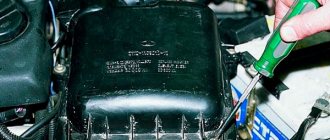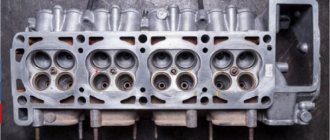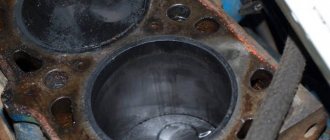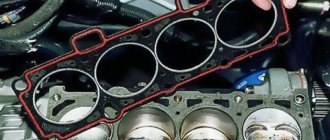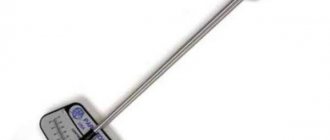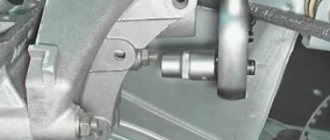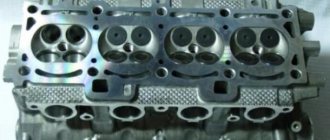If lubricant leaks from under the cylinder head, it means that the block is no longer sealed. This can lead to negative consequences and breakdown of the power unit. The head cover is a rather fragile structural part and requires special care.
If an oil leak is detected from under the cylinder head, you need to find out why this problem occurred and do everything to eliminate it.
Recommended reading: Priora eats oil
The essence of the breakdown
As we said earlier, there is a sealing element between the head and the block.
- Poorly tightened bolts. This usually occurs due to poor quality repairs.
- Deformation of the gasket itself (unfortunately, no one is immune from defects).
It is not always the gasket that causes an oil leak from under the cylinder head. Reason #2 is engine overheating. As a result, the surface of the cylinder head becomes uneven. Even after replacing the sealing element, oil leakage from under the cylinder head does not stop. It is necessary to grind the cylinder head or replace it with a new one. The latter option is often applied to heads that have cracks. There is no way to repair them. The structure has already lost its strength and tightness.
Installation
After removing the old gasket, prepare the surface. How to do it? We clean the surface of the block from dirt (and remnants of the old gasket, if any), and thoroughly degrease it.
The same goes for the area on the head. Both mating surfaces must be extremely dry and clean. Next, the gasket itself is installed. It is important to prevent it from moving relative to the mounting holes. The oil passage hole should be between the third and fourth cylinders. The sealant has already been applied to the surface of the sealing element. There is no need to smear anything additional. Next, the head is put on the engine and tightened with bolts. The camshaft and crankshaft should be at top dead center (when the valves of the first cylinder are fully closed).
What does this mean?
If the cylinder head gasket has broken, you need to fix this problem urgently. Otherwise, gases may leak into the cooling system. Outwardly, this manifests itself in white smoke from the exhaust pipe. The consistency of the coolant also changes. It will take on the appearance of a carbonated mineral water with many small bubbles. The candles begin to become coated with oil. Misfires appear. The oil level itself drops uncontrollably. If you overlook its level, you may encounter oil starvation. Because of this, the parts of the crank mechanism will work “dry”. The service life of the crankshaft is significantly reduced, and scuff marks appear on the cylinder walls.
Causes of engine oil leakage
Let's look at the main causes of this type of breakdown and ways to eliminate it. It is worth noting that it is best to have your car repaired at a technical service center and, if possible, not try to fix it yourself. The worst thing that can happen is a crack in the engine.
Oil leaks through the crankcase ventilation pipes
The most common cause of oil leaking from a car is considered to be insufficient ventilation of the crankcase. For many people, it is no secret that the majority of all vehicle exhaust gases escape through the piston rings. This fact is more pronounced if the engine is quite old and has been repaired many times.
After some time, the exhaust gases accumulate near the above-mentioned rings, creating excessively high pressure. The crankcase ventilation system precisely performs the function of reducing this excess pressure. When the ventilation channels are heavily clogged, this can cause minor oil leaks. It is worth noting that you need to constantly monitor the operation of the ventilation system, and in case of any malfunction, immediately prevent it. You won't be able to prevent oil leaks if your car's crankcase ventilation is faulty.
Do not forget the fact that preventing ventilation-related malfunctions will not be rational if the piston system of the car engine is quite old and has been repaired a number of times. Even with working ventilation, an excess amount of gases will break into the crankcase, which will lead to high pressure.
There are also other reasons for oil stains coming out of a car. There is often such an unpleasant picture when you open the hood of your car, and all the parts are simply immersed in oil.
The oil is constantly decreasing and careful monitoring is necessary. In particular, the most common places from which fluid leaks are the cylinder head cover and the oil pan. In both cases, the cause may be heavily compressed fastening bolts, which entails curvature of the surface.
Also, the reason may be quite frequent overheating of the engine, which also results in slight bending of the pan itself and the oil filler cap. Another, probably the most common reason, is the poor condition of the gasket. For example, the gasket has holes or severe abrasions.
Debugg
What to do if there is an oil leak from under the cylinder head? There is only one way out of this situation. This is a cylinder head gasket replacement. Its cost may vary. For VAZ cars, a new gasket costs about 400-500 rubles. The price of the product for foreign cars starts from 700 rubles and above, depending on the engine configuration. The cost of the replacement service is about one and a half thousand rubles. The operation requires the dismantling of many hanging elements. But if you wish, you can repeat this procedure yourself. Below we will describe the process of replacing the head gasket.
Why do leaks occur?
The power unit of modern cars is an expensive unit; its cost is quite a bit lower than the price of the car body. Therefore, he will require an attentive attitude towards himself and timely completion of all types of maintenance. Only in this way can a long period of its operation be ensured. When problems are noticed in the power unit, and oil leaks in the cylinder head area are fully related to them, you should identify the cause yourself or with the help of specialists, and then eliminate it.
Oil leaks can be detected in the following places:
- Lubricant entering the combustion chamber of the engine cylinder;
- Mixing oil with coolant;
- Leakage onto the outside of the cylinder block.
The main cause of such problems is almost always a burnout of the cylinder head gasket, but occasionally damage to the cylinder head also occurs.
The engine housing and cylinder head have an extensive network of channels for lubricant supply and coolant supply. This ensures lubrication of the mechanisms and removal of heat from the combustion of the fuel mixture. The connection between the block and the head is ensured by the cylinder block gasket. Defects in its manufacture or improper installation can cause oil leaks.
Depending on where the damage or burnout of the gasket occurs, engine oil will leak. The most “harmless” case will be the moment when traces of leaks are found on the outer sides of the engine housing. As noted earlier, you can continue moving further when it is possible to add lubricant to the motor. If you and your car were far from your place of residence, then you can get home this way.
Responsible drivers conduct a brief inspection of the technical condition of the vehicle every day before leaving. Inspect everything for leaks, check the level of engine oil and coolant. Check the air pressure in the tires and the operation of the lighting and alarm systems. But there are also those who do not look under the hood of the car from one service to the next. In this case, on a dirty engine it will be difficult to determine the location and cause of such a problem until it is cleaned of dirt and oil stains.
Engine oil getting into the combustion chamber or engine cooling system is a serious problem that can lead to significant costs to fix it. The engine should be stopped and a tow truck or tow truck used to get home. This is somewhat costly, but will avoid further progression of the fault.
How is the replacement made?
Looking ahead, we note that an important condition during the replacement is the correct tightening of the head bolts. This is the only way to achieve a tight and high-quality surface fit. Otherwise, the integrity of the gasket will be compromised, and the oil will come out again, along with the exhaust gases. The tightening torque for each car is individual and is indicated in the operating instructions.
- Ignition coils.
- High voltage wires.
- Air pipes and intake manifold.
- Sensors (throttle position, idle speed, etc.).
- Vacuum booster hose.
Before removing the cylinder head, you need to drain the coolant. Otherwise, when dismantling, you will flood the entire engine with it. If the antifreeze is fresh, it can be reused. The main condition is a clean container for draining and the transparency of the liquid itself. If it has lost its color (remember, it can be red, blue or yellow) or has become cloudy, such a product cannot be reused.
Note! The camshaft and crankshaft should not be rotated until the belt has been reinstalled.
How to remove the cylinder head? Keep in mind that the cylinder head bolts may become stuck. To prevent the key from falling off, clean the edges as much as possible from dirt and deposits. Otherwise, you will not be able to unscrew the bolt. Due to the licked edges, it can only be drilled out, which is extremely difficult and dangerous for the engine block.
Next, inspect the head mounting bolts. They should not be elongated. If this is the case (for example, the length of the bolts on Lada Samara engines is no more than 135.5 millimeters), they are replaced with new ones. Before installation, the threads must be treated in oil.
What is important to know about crankcase gas pressure?
By changing the valve cover gasket, you often only eliminate the consequences of the malfunction for a short time. It is much more important to determine the causes of lubricant leakage, since neither the exemplary geometry of the mating planes, nor a high-quality gasket and following the instructions will protect against oil leakage if there is an increased pressure of crankcase gases inside the engine. The crankcase mixture consists of an unburned air-fuel mixture that penetrates the crankcase through the piston rings and an oil suspension. The operation of the exhaust gas ventilation system is aimed at supplying the explosive mixture back into the intake tract.
Video: Checking crankcase gases
- PCV valve. Necessary to regulate the amount of exhaust gases entering the throttle body;
- oil separator To avoid contaminating the intake tract with oily deposits, gases pass through an oil trap. It can be cyclic or labyrinth type, with or without an additional mesh element installed. Most often, in a clogged state, there are systems with a replaceable paper filter element;
- supply pipes and ventilation hoses.
Increased gas pressure inside the engine occurs in 2 cases:
- VKG system malfunction. Most often, the passage of gases is impeded by a clogged oil separator; less often, a breakdown of the PCV valve occurs;
During the frosty season, even a working crankcase ventilation system can become clogged. The reason is the emulsion that accumulates inside the hoses and pipes leading to the intake tract. Due to numerous heating and cooling cycles, moisture condenses inside the tubes, which, when mixed with oil vapor, turns into an emulsion. The accumulation of milky mass reduces the flow area of the ventilation hoses and leads to increased pressure inside the engine.
- excess volume of crankcase gases. Occurs when the cylinder-piston group is critically worn. There is so much unburnt fuel injection and exhaust gases that even a working VCG system is not able to redirect the entire volume into the intake tract.
Puff
As for tightening, it is done in four stages. Let's look at the technology using the example of the second generation Lada Samara engine. First, the bolts are tightened with a force of 20 Nm. Further, the force increases to 70-85 Nm. At the third stage, the bolts are turned by 90 degrees, at the fourth - by the same amount. After this, the replacement of the gasket can be considered almost complete. Now you know what to do if an oil leak occurs from under the cylinder head.
Engine oil leaks
If the driver nevertheless discovers some accumulation of black liquid spots on the floor, then he seriously thinks about this strange fact and immediately goes to the vehicle maintenance point in order to identify and prevent the malfunction as quickly as possible. Despite all this, you can do a procedure such as an oil leak in a car yourself without much effort.
Let's take a closer look at this topic and look at the reasons why oil leaks appear on a car engine.
How to find out if the cylinder head gasket is blown
You can determine whether the cylinder head gasket is blown by using one of several methods. In this case, diagnostics are simple and can be done by anyone, even a novice and inexperienced driver.
To check the integrity of the gasket, you must do one of the following:
- With the engine running, visually inspect whether smoke is coming from the gap between the cylinder head and the cylinder head . Also listen to see if there are loud ringing sounds coming from there that were not there before.
- Inspect the surfaces of the radiator caps and expansion tank of the cooling system, as well as the neck for filling oil into the engine. To do this, you just need to unscrew them and visually inspect them. If antifreeze gets into the engine, there will be a reddish emulsion on the oil filler cap. If oil gets into the antifreeze, then there will be oily deposits on the radiator or expansion tank caps.
Sealant instead of rubber gasket
In the design of the cylinder head and valve cover of some cars, anaerobic sealant is used instead of a rubber gasket. Our car enthusiasts know the technology from the 16-valve engine, first installed on the VAZ 2112. In it, the valve cover is a single part with the upper camshaft bed. Due to their physicochemical properties, anaerobic compounds can withstand high temperature loads and vibrations. But engines of this design also require periodic resealing of the upper bed of the camshafts. To permanently eliminate leaks in the lubrication system, consider the following:
What to do if the cylinder head gasket is blown
Many drivers are interested in the question: is it possible to drive with a broken cylinder head gasket ? The answer is simple - it is possible, but not advisable, and only for short distances, in particular, to a garage or car service for repair work. Otherwise, the consequences of a blown cylinder head gasket can be very dire.
If, as a result of the diagnostics, it turns out that the gasket has broken, then nothing can be done about it except to replace it. It is also worth inspecting the adjacent surfaces, and most importantly, try to find out the true cause of the burnout... The price of the gasket can be different and depends on the brand of the car and the manufacturer of the spare part itself. However, compared to other nodes it is low. Repair work may cost you a little more than simply buying a gasket. The point is that the following points must be taken into account:
- If during the process of dismantling the cylinder head it is discovered that the mounting bolts have become loose and do not meet the technical parameters, they will need to be replaced. And sometimes situations happen when, due to a change in the geometry of the cylinder head, the bolt cannot be unscrewed, and you simply have to tear it off. There is appropriate equipment to carry out this unpleasant procedure. Often modern engines are equipped with bolts that operate at their yield limit. This means that after removing the cylinder head (to replace the gasket or for other reasons), it is necessary to buy and install similar new ones.
- If the plane of the cylinder head is damaged, it will be necessary to grind it. To do this, they use special machines, the work of which will also cost money. However, the working plane of the cylinder head “leads” not so often, but it is still worth checking this parameter. If the surface has been ground, a new gasket must be purchased, taking into account the thickness of the removed metal layer.
Before replacing the gasket yourself, you must clean the head of carbon deposits, scale and pieces of the old gasket. Next, you need to inspect its surface. To do this, use a special measuring tool, usually a ruler. It is passed along the surface, revealing the presence of gaps. The size of the gaps should not be more than 0.5. 1 mm . Otherwise, the surface of the head must be sanded or completely replaced with a new one. Instead of a ruler, you can use a thick sheet of glass (for example, 5 mm thick). It is placed on top of the surface of the head and looked for for possible air spots. To do this, you can lightly lubricate the surface of the head with oil.
Checking the cylinder head surface
When replacing the gasket, it is recommended to lubricate its surface with graphite lubricant. This way it will become softer and easier to find “its” place on the surface of the cylinder head. In addition, it will be easier to remove when dismantling. The advantage of graphite lubricant in this case is that graphite is not squeezed out during operation, turning into ash.
After repair work, the car owner must monitor the behavior of the engine. Do the malfunctions described above reappear (white smoke from the exhaust pipe, emulsion or greasy spots in the coolant, oil at the junction of the cylinder head and cylinder head, no engine overheating, and so on). Moreover, immediately after replacement, you should not operate the engine at maximum power. It is better for the gasket to “settle” and take its place.
What is the cylinder head made of?
Until recently, all cylinder heads were cast iron. Nowadays, most modern engines are equipped with aluminum cylinder heads. True, there are cases when using cast iron heads is more appropriate. Such cases include operating a vehicle in difficult conditions. At high temperatures, cast iron deforms less than aluminum. But even taking into account this nuance, the cast iron head is almost history. To solve this issue, manufacturers of powerful engines use gaskets made of special substances. They withstand the highest temperatures without deforming and ensuring the tightness of the system.
Nature of the problem
Between the cylinder block and its head there is a lining that is designed to ensure tightness. It is impossible to assess its condition visually. The reasons for oil leaking from under the BC head can be very different: insufficiently tightened bolts, a deformed lining, a cracked head. If you notice deformation of the lining, you need to contact a specialist.
The cylinder head gasket plays an important role
Leaking, the lubricant enters the cooling complex. Such a leak can be detected by looking into the radiator or expansion tank. Leakage of oil fluid threatens to reduce the amount of car oil, therefore, car parts are not properly lubricated and wear out quickly. Leaking lubricant can get into the cylinder block and oil the spark plugs. In this case, not only the lining will be damaged, but also the valve seals.
Main parts of the cylinder head
The cylinder head consists of removable and non-removable parts. Removable ones include:
- frame;
- holes in which threads are cut for tightening spark plugs;
- pad;
- gas distribution mechanism;
- gas distributor drive;
- collector mountings.
The non-removable elements of the cylinder head include valve seats, the function of which is to ensure the tightness of the gas distribution mechanism, and valve guide bushings. They are pressed “hot” into the body. Replacing such parts is possible, but this requires the use of specific equipment.
It is not recommended to change them in the garage, since the geometry of the cylinder head may change as a result of different degrees of heating. In this case, the head will not seal tightly to the block, and the cylinder head will fail soon.
What is the risk of gasket deformation?
If you do not replace the cylinder head gasket, which is damaged, the oil/coolant will leak. Antifreeze can leak into the combustion chamber and lubricant complex. Exhaust gases will enter the cooling system through the deformed gasket.
A sure sign that the seal is broken is the presence of gas mixtures under the rim of the automobile combustion chamber. You may notice heavily blackened areas on the metal of the edging or on nearby parts of the lining. The lining material in the area of penetration of heated gas mixtures begins to quickly deteriorate. Blackening of the entire surface is not a sign that the liquid is leaking. This is normal when the vehicle is used intensively.
Which gasket material is better?
Gaskets made of different materials
When replacing a gasket, many car owners have a reasonable question: which gasket is better - metal or paronite? Each of these materials has its own advantages and disadvantages. At the same time, you need to understand that if the manufacturer recommends using gaskets made of a certain material, then you must adhere to these requirements.
As a rule, a metal gasket is stronger than its paronite counterpart. Therefore, it is advisable to install it on powerful turbocharged or forced engines. If you do not plan to tune the engine of your car, but simply operate it in a gentle mode, then the choice of material does not matter much to you. Accordingly, a paronite gasket is quite suitable. Moreover, this material is more flexible and is able to adhere more tightly to work surfaces.
Causes of damage to the lining
- Gases. Exhaust gases enter the area between the 2nd and 3rd cylinders. The gasket elastomer is deformed in the area of the coolant passage hole. This problem may be caused by the following: loose bolts; dropped cylinder liner; deformed parts; rough surface of spare parts; incorrectly adjusted start of fuel intake.
- The section of the hole for the pusher has delaminated. This may be due to: high loads on the motor; incorrect installation of the sleeve protrusion; uneven surface of the cylinder head.
- Overheating. Thermal overheating of the lining causes the seals to rupture. Overheating can occur due to a low octane index of the fuel, increased compression levels, or incorrectly adjusted spark plugs. Typically, overheating causes the gasket material to swell near the antifreeze passage holes.
- Flow of lubricant over the surface. Typically, pads are used that consist of metal and elastomer. Grooves are formed in the cylinder head, which are sealed with gasket seals. If these grooves are not properly cleaned of dirt or carbon deposits, an oil leak occurs. If installation errors are made, the elastomer layer may become wrinkled. This increases the chance of depressurization.
- Installation errors. Most often, lubricant leaks from under the gasket due to poorly tightened bolts, so it is advisable to repair or change the lining in a specialized car service center whose employees you can rely on.
- Incorrect choice of pad. Often the dimensions of the combustion chamber do not correspond to the size of the lining. An unsuitable gasket, if installed in the motor, will soon be damaged. Also, you should not install products that are manufactured by an unknown company. The oil will continue to leak even after replacement if you use a low-quality lining.
An oil leak is considered a fairly significant problem. Having identified it, you need to immediately take measures to correct it. All procedures are best carried out in car services. This is especially true if you, for example, are a fragile girl in stiletto heels. Do not touch the power unit, much less dismantle it. This can lead to complete breakdown of the vehicle. It will be necessary to carry out major repairs, which are very expensive. It’s easier to immediately pay specialists to fix the oil leak. This way you will spend much less of your own money. The main thing is not to ignore the malfunction. A minor problem can very likely turn into a serious breakdown that makes the vehicle impossible to operate.
«>
Why is oil leaking?
The main reason for this lies in the malfunction of the head itself and the gasket under it. The oil line and coolant pass through the cylinder head, so if the oil line is damaged, oil will begin to flow into the cooling system and will leak from under the head. This type of leakage is also an indication of a damaged head gasket. The consequences can be the most unpleasant - as the oil decreases, the lubrication of the engine's rubbing parts will deteriorate, which will very soon lead to their jamming. And this will entail, at a minimum, a major overhaul of the engine.
What to do if oil leaks from under the cylinder head? The most important thing is to establish the cause - after all, oil may be leaking from under the valve cover. As soon as the cause of oil leakage is established, you need to immediately take measures to eliminate it - simply wiping off the oil stains and calming down will not be enough. If oil is leaking from under the valve cover, then the gasket is most likely damaged. Although it is made of high-quality oil-resistant rubber, nevertheless, this sometimes happens. If oil leaks directly at the junction of the cylinder head and the block, then there may be several reasons - improper tightening of the bolts, damage to the gasket, and, most unpleasantly, damage to the head itself. If in the first case it is enough to tighten the bolts correctly, and in the second case to replace the gasket, then with the head it will be more difficult, here it all depends on the degree of damage. It also happens that oil leaks from under the spark plugs - this also indicates damage to the cylinder head - oil should not get into the cylinders.
Some car owners, having discovered that oil is leaking from under the cylinder head, do not understand the seriousness of the situation. And the lack of oil is compensated for by periodically adding it. Such a solution is completely unacceptable - after all, at the most inopportune moment the engine may fail. And no one can say when this will happen. But even after eliminating the malfunction, it is advisable to monitor the oil level not only by the sensor, but also by checking it with a dipstick. It might seem like a harmless drop of oil, but if you don’t take action, it can lead to major troubles. Therefore, it is strongly recommended to take corrective action as soon as possible upon detection.
Causes of oil leakage from under the valve cover
Oil leakage can occur through the oil filler neck, in the place where the valve cover adheres to the cylinder head, as well as in the places where the cover is attached to the cylinder head with bolts.
Less commonly, oil leaks can be found on the valve cover body itself. This indicates defects and cracks in the case, and there may also be a manufacturing defect.
As you know, motor oil in the engine lubrication system is supplied to various elements and components of the internal combustion engine under a certain pressure, which is created due to the operation of the oil pump.
- If an oil leak is noticed in the area of the bolted connection or lubricant leaks out of the neck, then experts consider the most likely cause to be an increase in pressure in the engine lubrication system.
- The presence of oil leaks at the junction of the cover and the cylinder head may also indicate an increase in pressure in the system. In parallel with this wave, wear of the gasket or insufficient sealing in the area of \u200b\u200bthe connection between the valve covers and the cylinder head is allowed.
Note that the valve cover gasket is a rubber product. Moreover, the operating conditions of this seal are such that the specified element operates taking into account a constant temperature difference (high heating and cooling). It is quite obvious that rubber under such conditions gradually loses its elasticity and hardens, and cracks appear in the structure of the material. As a result, the gasket no longer fits tightly to the surfaces of the cover and head. In this case, the problem is solved by replacing the valve cover gasket.
Let us add that the above statements also apply to the cylinder head gasket. Oil can also leak from under the cylinder head if the pressure in the lubrication system increases, and also as a result of defects in the head gasket. The only thing is that in this case you need to pay attention to the condition of the mating planes of the head and the cylinder block itself.
It should also be noted that traces of oil and grease drips on the engine can also appear when the leak occurs through the exhaust manifold gasket. It happens that craftsmen come to a hasty conclusion that oil is leaking from under the cylinder head, after which they immediately begin to change the cylinder head gasket.
Moreover, in many cases such a leak looks similar in appearance to a head gasket leak, although the oil actually leaks through the manifold gasket. During diagnostics, this fact must be taken into account; it is recommended to check this element separately.
Oil leak from under the valve cover: high pressure in the engine lubrication system
So, if everything is clear with the gaskets, then oil leaks as a result of high pressure in the lubrication system require separate engine diagnostics. One of the main methods at the initial stage can be considered to measure the oil pressure in the lubrication system.
To measure the oil pressure that is created in the channels of the oil system, it is necessary to clarify in advance what indicator is considered normal for a particular type and model of internal combustion engine. This information can be found in specialized technical literature, clarified on specialized auto forums, etc.
For measurements you will need a liquid pressure gauge. Next, the oil pressure sensor is unscrewed, after which a pressure gauge is installed in its place and the oil pressure in the engine is measured. If the pressure gauge readings indicate that the recommended value is exceeded, then an oil leak from under the valve cover will be a natural result.
Useful tips and tricks
- It should be remembered that high-quality elimination of oil leaks from under the valve cover requires the correct choice of gasket under the valve cover. To do this, it is optimal to purchase original products or high-quality recommended analogues from well-known manufacturers.
- Before purchasing, the gasket should be carefully inspected, checked for elasticity, and made sure there are no sagging or other defects. The element should not be hard or overdried; even the smallest cracks are not allowed.
- For vehicles that use sealant on the valve cover, only recommended or proven sealant compounds should be used. In this case, it is imperative to strictly follow the application technology.
